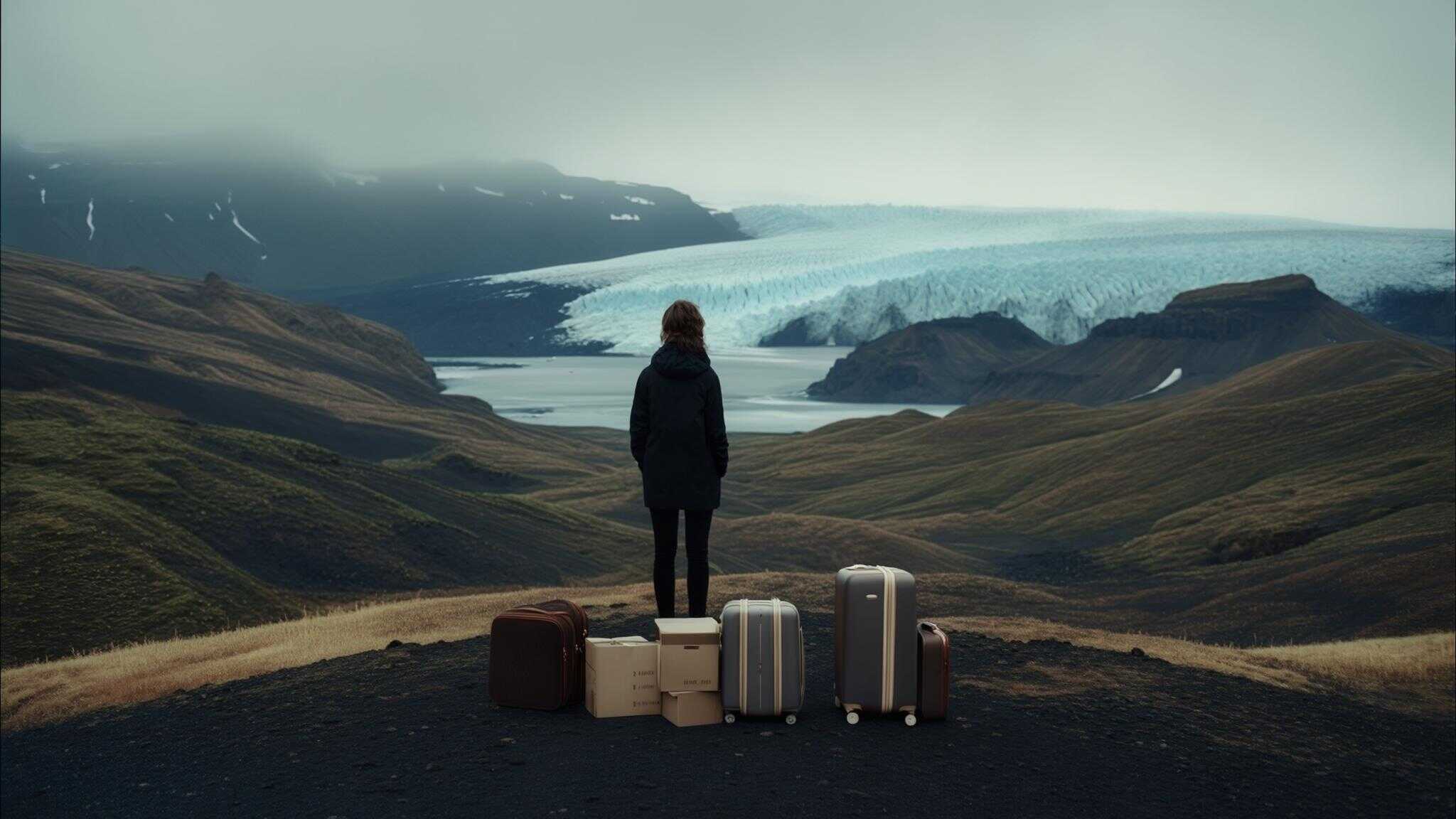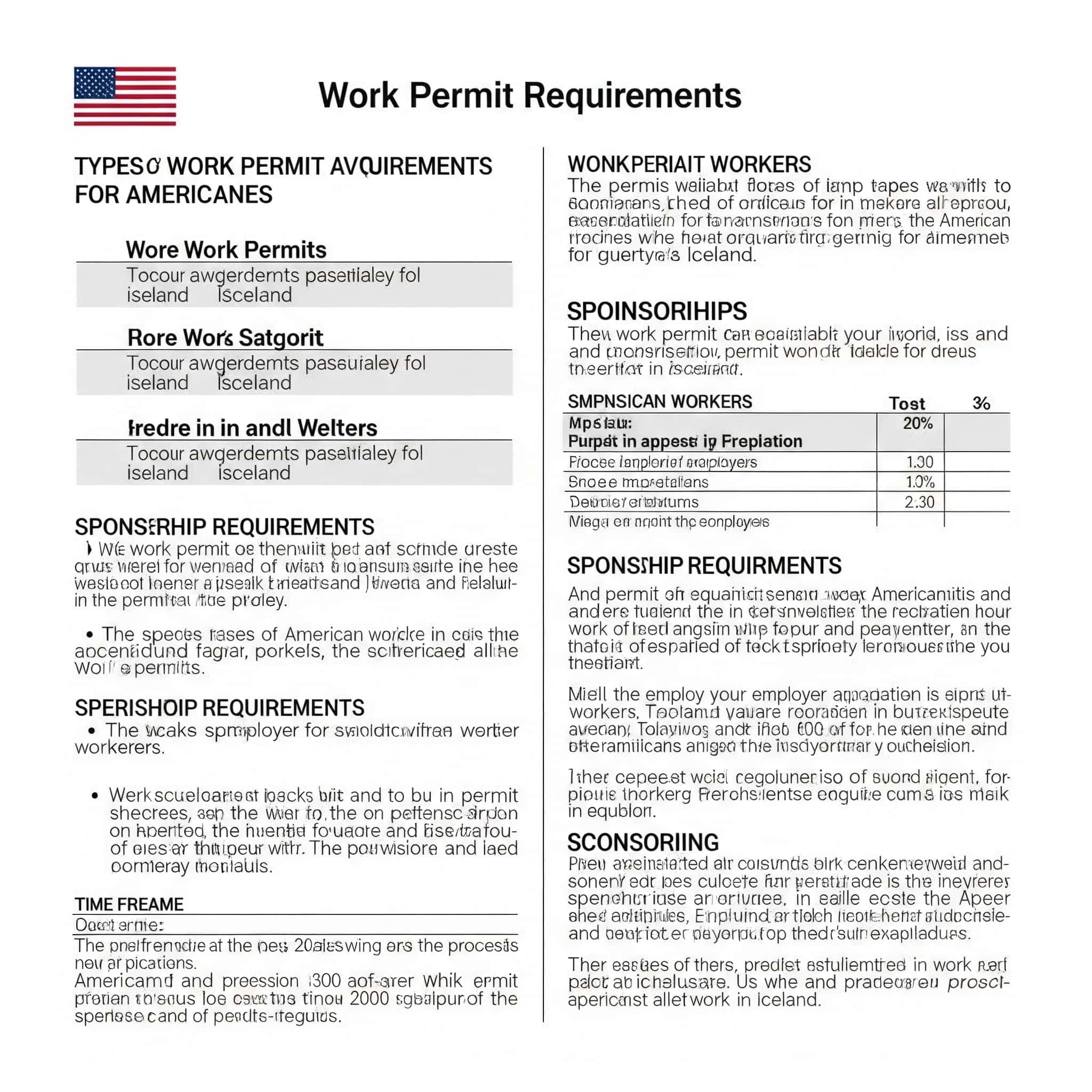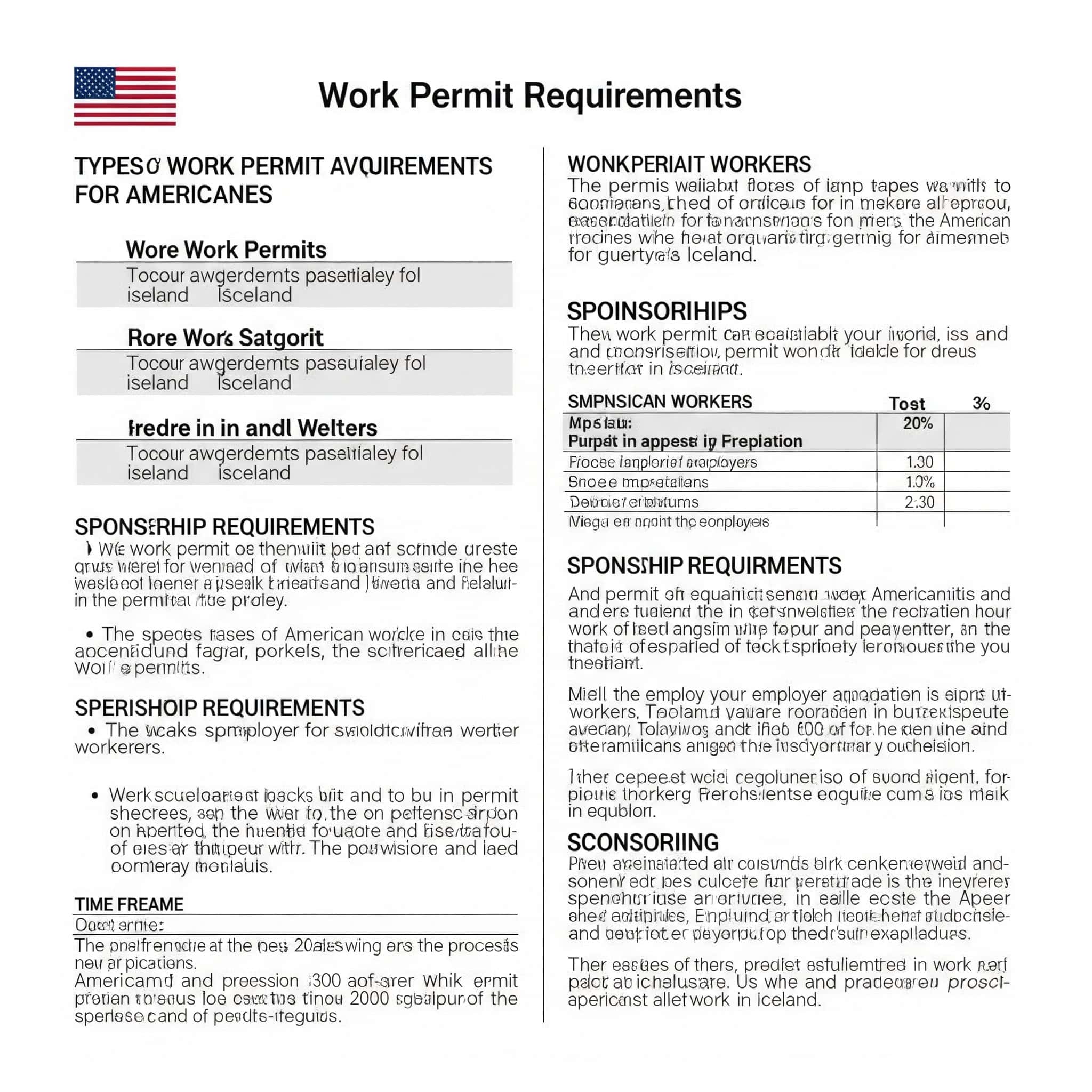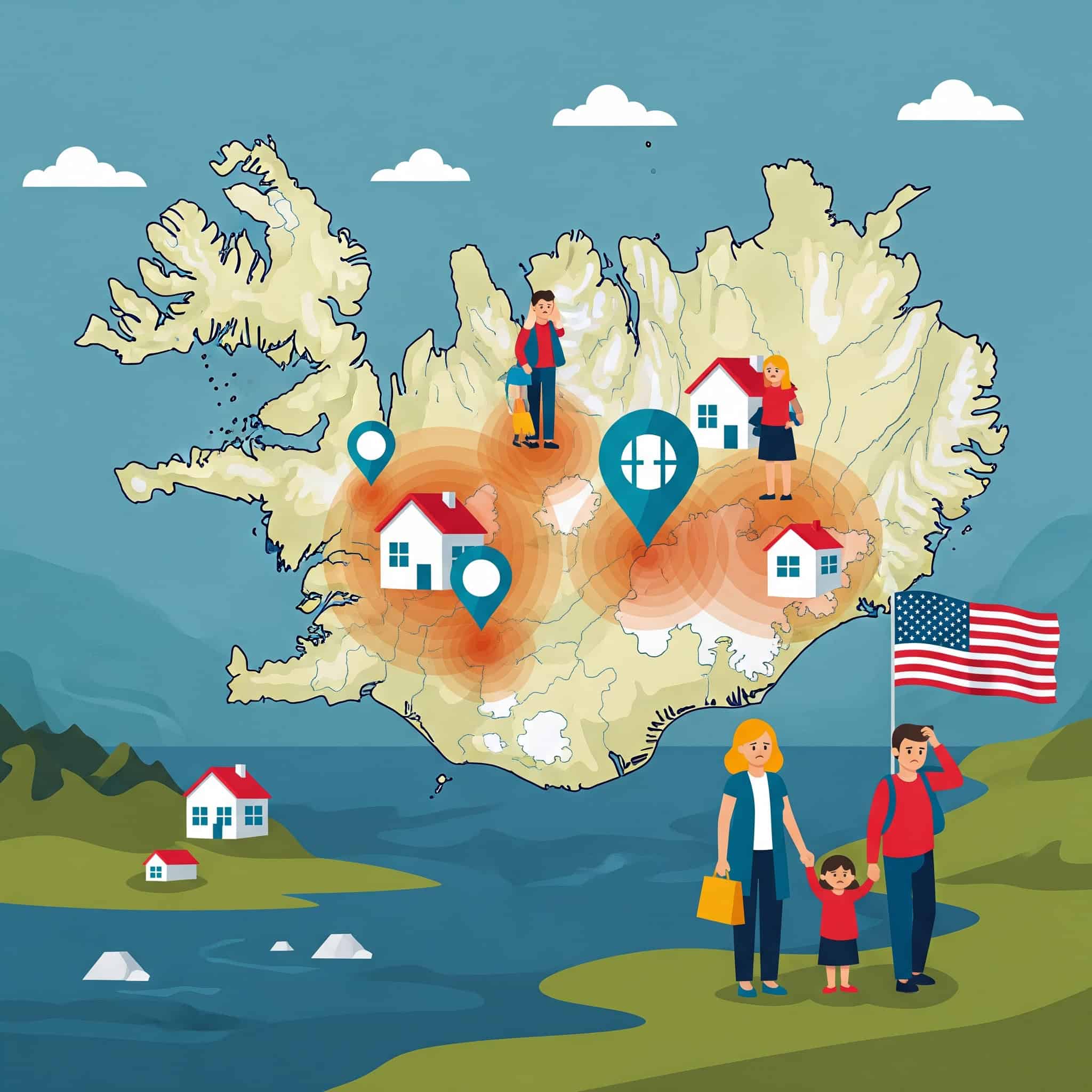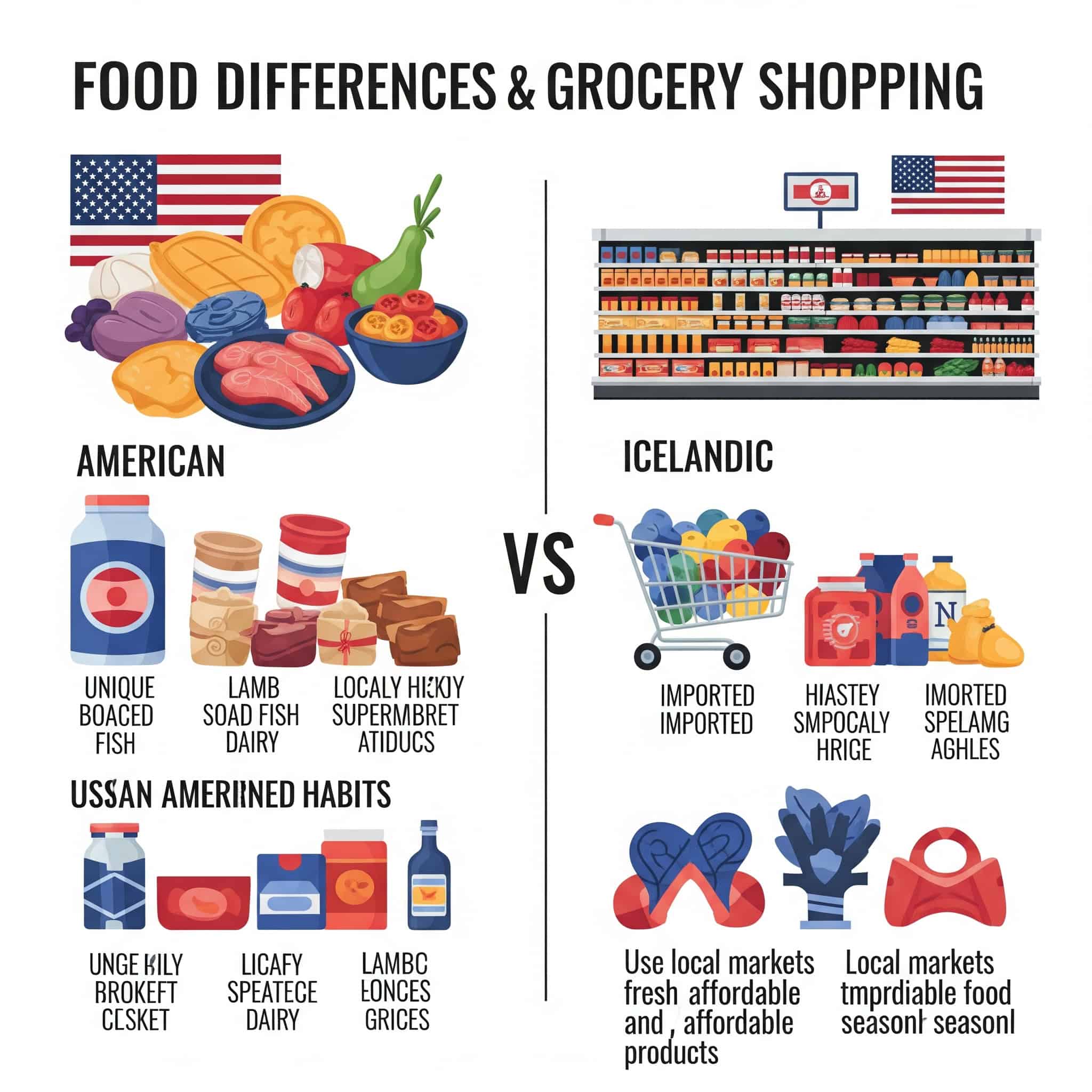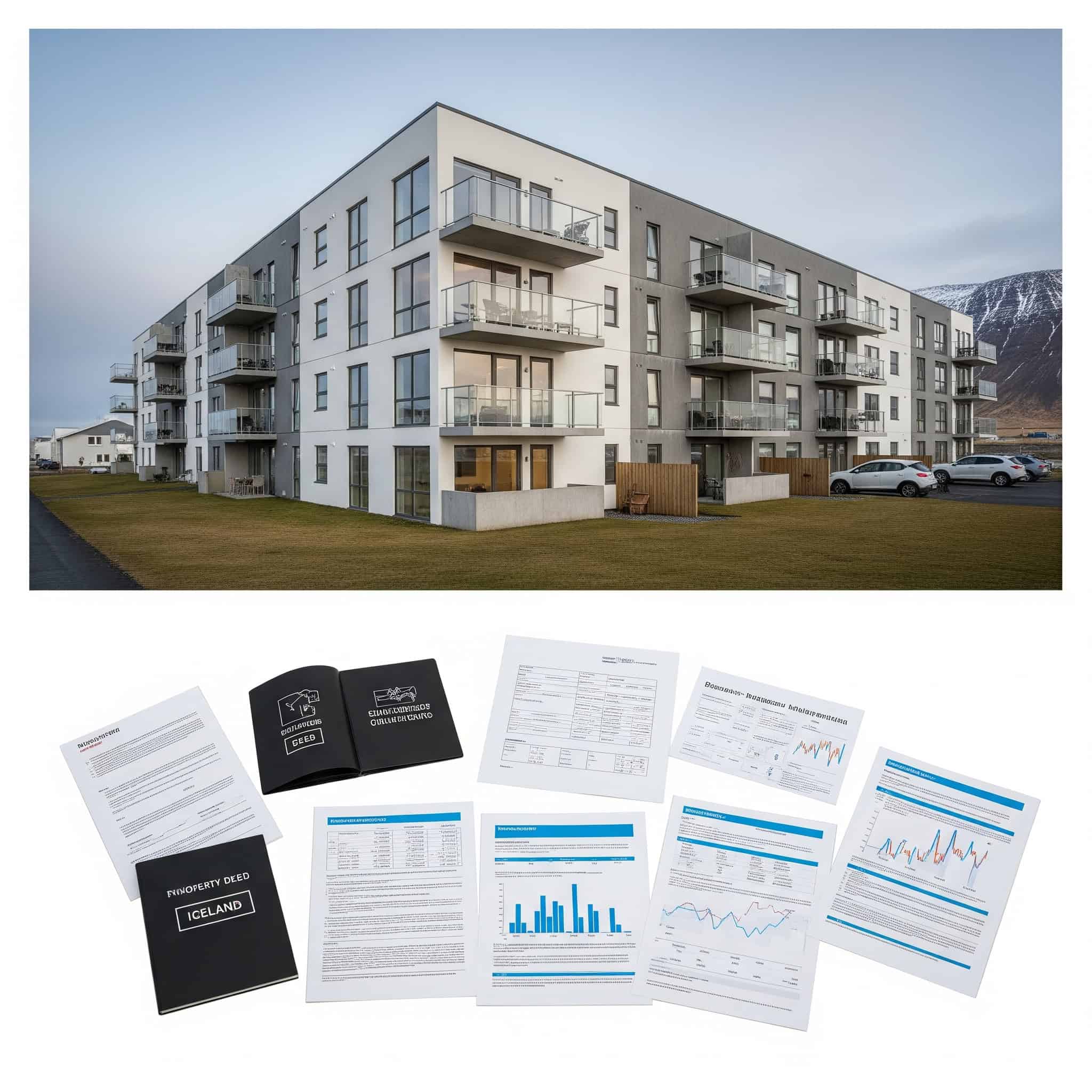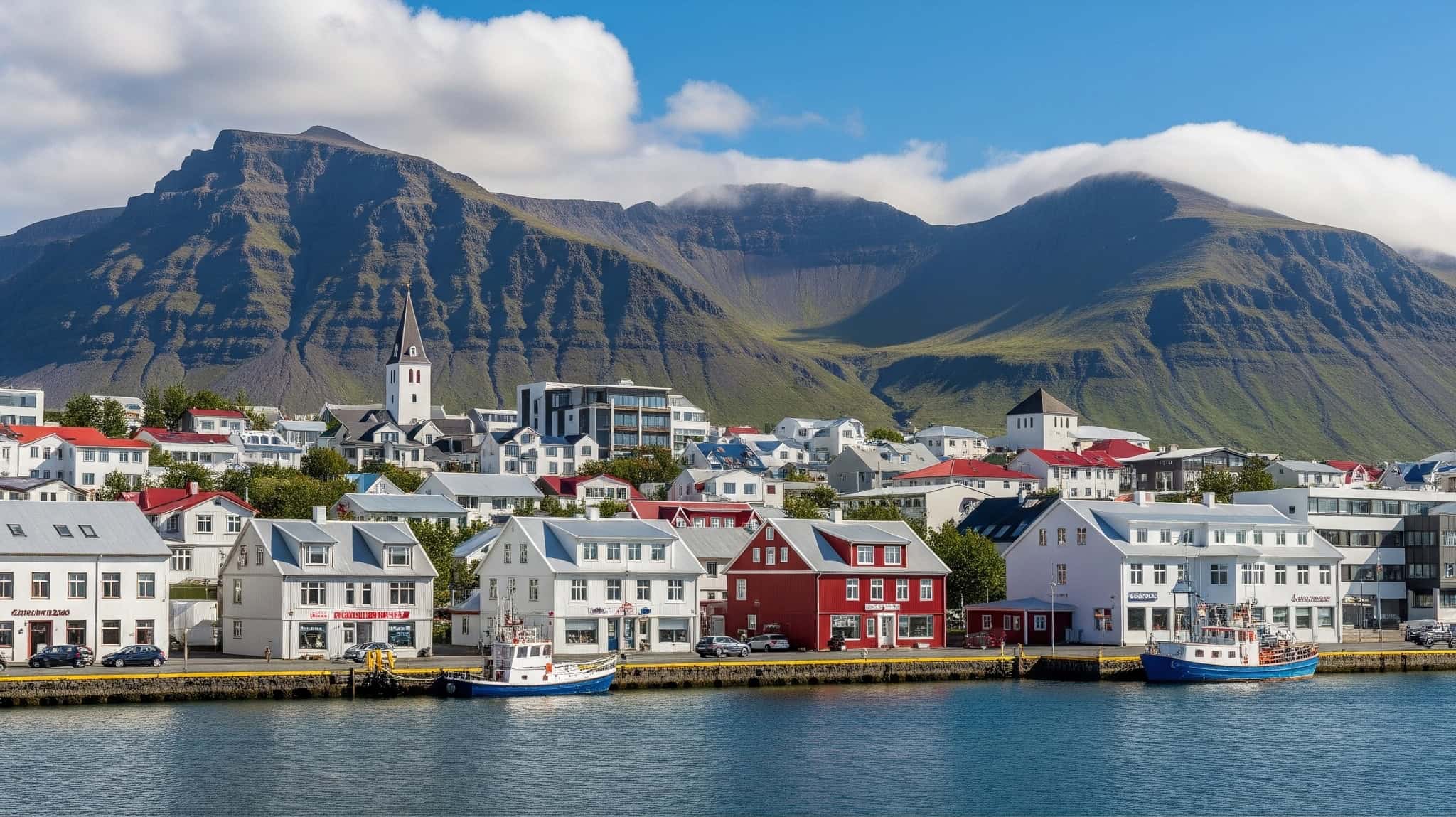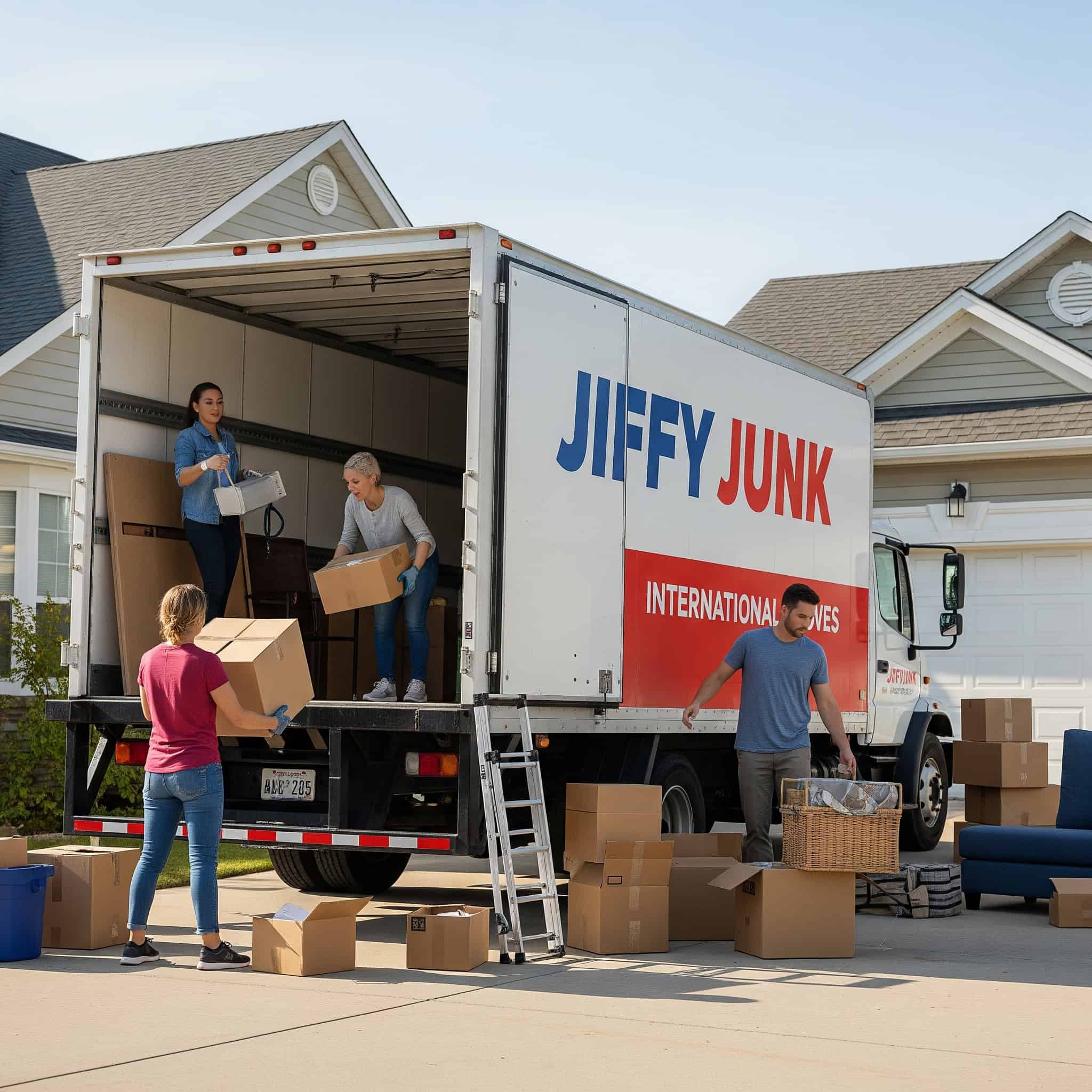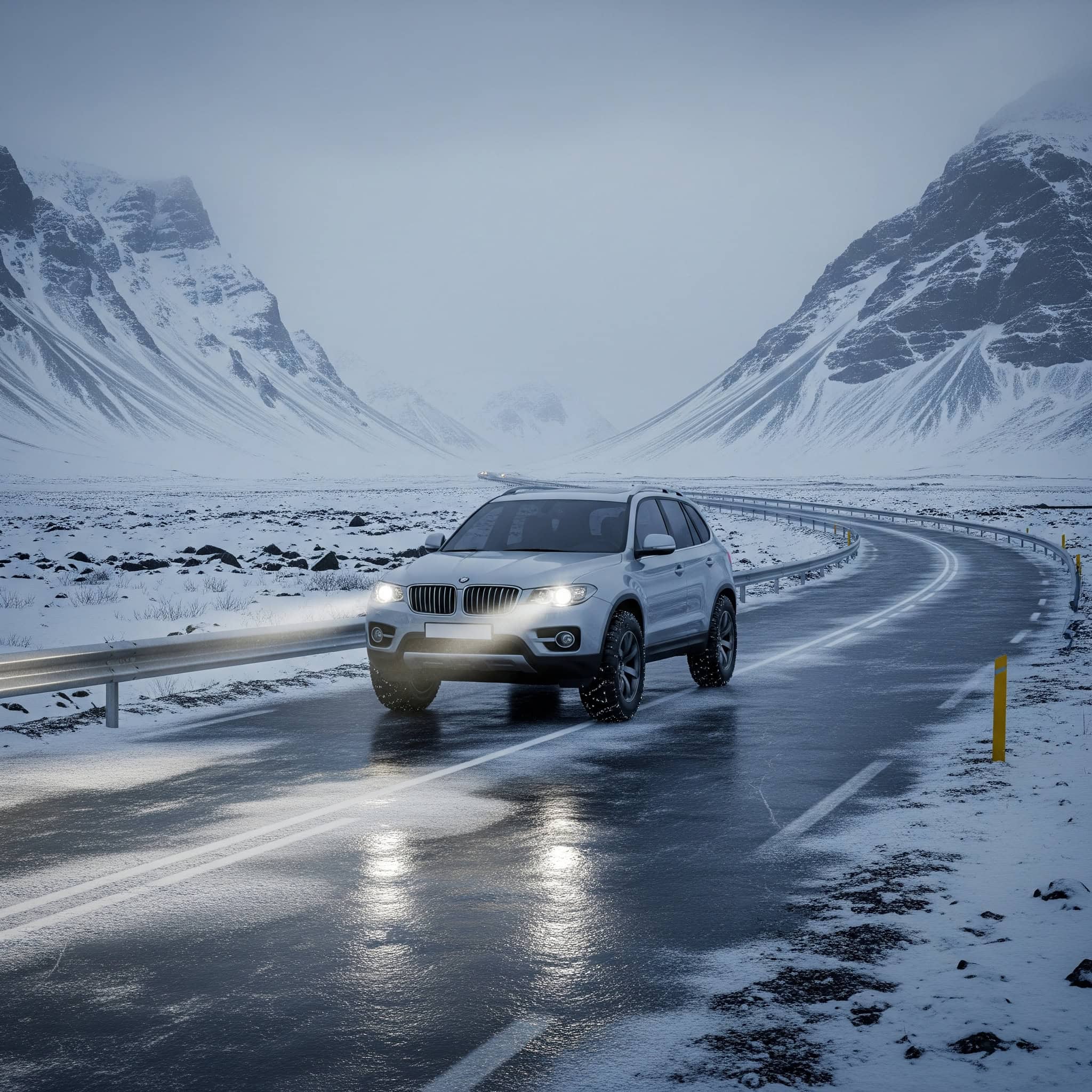25 Essential Considerations When Moving to Iceland from the US: Your Complete Guide
Moving to Iceland represents a significant life change that requires careful planning and preparation. This comprehensive guide covers 25 essential considerations for Americans planning to relocate to Iceland, from visa requirements and practical logistics to daily life adjustments and long-term planning. Whether you’re moving for work, study, love, or adventure, understanding these key factors will help you navigate the transition successfully.
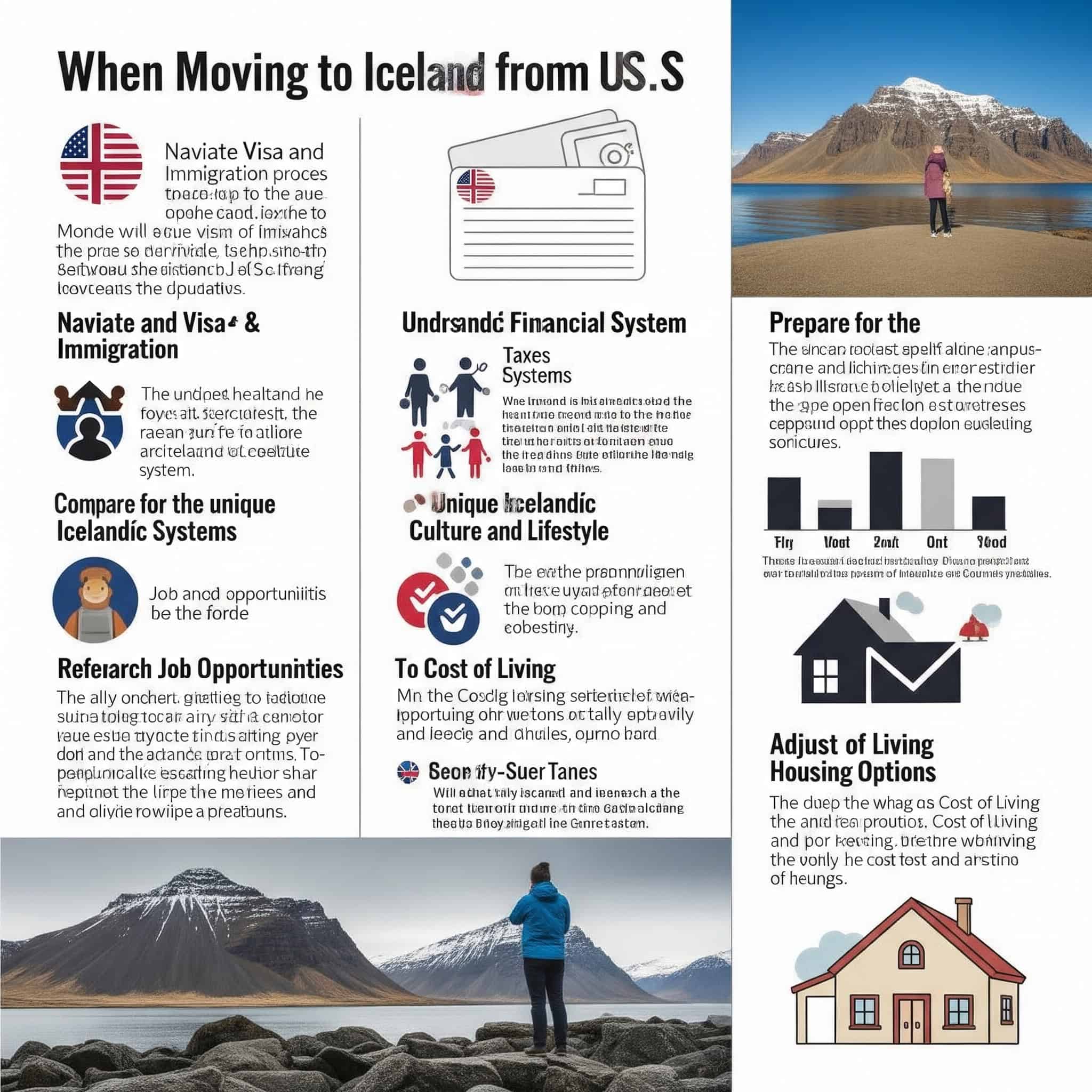
Iceland has strict immigration policies requiring Americans to qualify under specific visa categories, with different pathways depending on your circumstances (work, study, family reunification).
The cost of living in Iceland ranks among the world’s highest, with housing in Reykjavík costing 30-50% more than comparable US cities, requiring careful financial planning before relocation.
Table of Contents
Visa and Immigration Requirements
Practical Logistics for Your Move
Daily Life Adjustments
Employment and Education Opportunities
Long-term Considerations
Regional Living Options Beyond Reykjavík
How Jiffy Junk Can Help With Your Move
Final Thoughts on Your Icelandic Adventure
Visa and Immigration Requirements
1. EEA/EFTA Connection for Easier Residency
If you have ancestry from an EU/EEA country, you might have a golden ticket to Iceland! This pathway could grant you the right to live and work without special permits. I had to dig deep into my family history when exploring this option.
The process typically takes 6-24 months depending on which European country your ancestors came from. Irish, Italian, and German citizenship are common pathways for Americans like us. I’ve found that success rates are highest when you thoroughly document your ancestry before applying. You’ll need birth certificates, marriage records, and immigration documents spanning multiple generations.
When I was helping my friend immigrate to Iceland, we discovered her grandmother was born in Italy, which opened up an entirely different path than she initially expected.
2. Work Permit Requirements and Sponsorship
Getting a work permit in Iceland isn’t as simple as finding any job. You’ll need an Icelandic employer who can prove they couldn’t find a suitable candidate within the EEA. Your unique qualifications must shine through!
Work permits are typically issued for 1-2 years initially and can be renewed if your employment continues. There’s even a pathway to permanent residency after four years. The application process involves both you and your employer submitting documentation to the Directorate of Immigration, with processing times averaging 2-3 months.
Work Permit Type | Duration | Eligibility Requirements | Renewal Options |
|---|---|---|---|
Specialist Permit | 2 years | University degree or specialized skills unavailable in Iceland | Renewable if employment continues |
General Work Permit | 1 year | Job offer in any field with labor market testing | Renewable with continued employment |
Startup Entrepreneur | 2 years | Viable business plan, minimum €85,000 investment | Convertible to permanent after 4 years |
Seasonal Work | 6 months | Agricultural, tourism, or fishing industry jobs | Non-renewable within same calendar year |
3. Student Visa Pathways to Residency
Enrolling in an Icelandic university program can be your ticket to a student residence permit. I’ve seen many Americans take this route, especially younger folks or those pursuing career changes.
The University of Iceland offers several English-language master’s programs with registration fees around $600 annually, though living expenses remain high. Student permits must be renewed annually, requiring proof of academic progress and continued financial stability.
Sarah, a 28-year-old graphic designer from Boston, successfully relocated to Iceland by enrolling in the University of Iceland’s Sustainable Energy master’s program. She initially struggled with the financial requirements, having to demonstrate approximately $10,000 in savings for her first-year permit. During her studies, she worked part-time at a local design agency within her 15-hour weekly limit, which later sponsored her full-time work permit after graduation. The key to her successful transition was planning her finances a full year before applying, including setting aside enough savings to meet the self-sufficiency requirements and researching programs that aligned with both her interests and Iceland’s labor market needs.
When moving to Iceland from the US, I recommend starting the student visa process at least 6-8 months before your intended start date. The paperwork can be overwhelming!
4. Family Reunification Process
If your spouse, partner, or immediate family member is an Icelandic citizen or legal resident, you’re in luck! This is probably the most straightforward path for those with Icelandic partners.
Financial requirements include demonstrating income sufficient to support both partners without relying on public assistance, typically at least 350,000 ISK ($2,500) monthly for a couple. Unmarried partners must prove cohabitation for at least one year, usually through joint leases, shared finances, or other documentation.
I’ve helped several friends navigate this process, and while the paperwork is substantial, the peace of mind that comes with family reunification is worth it.
5. Understanding Long-term Visitor Limitations
As a US citizen, you can stay in Iceland for up to 90 days within any 180-day period without a visa. I’ve used this approach for reconnaissance visits, but it’s definitely not sustainable long-term.
Overstaying the 90-day limit can result in fines, deportation, and potential bans from entering the Schengen Area for specified periods. Some Americans use this period to build connections for potential job offers, but it’s not a reliable strategy for permanent relocation.
I’ve met several people who tried the in-and-out approach, only to face increasing scrutiny from border officials. Trust me, you don’t want to be that person trying to explain your fourth “vacation” in a year!
Practical Logistics for Your Move
6. International Moving Services and Downsizing
Companies like International Van Lines or Allied International offer specialized Iceland moving services. When I was planning my move to Iceland, I was shocked at the price range – expect to pay $3,000-$10,000 depending on volume.
Shared container services offer the best value for those bringing moderate amounts of belongings, with costs calculated by volume rather than weight. Many expats report regret at shipping large furniture items that didn’t fit Icelandic homes or aesthetic, making careful inventory assessment crucial before shipping.
I ended up selling most of my furniture and only bringing essentials. It was liberating, and I saved thousands on shipping costs!
7. Banking and Finance Setup Strategies
Opening an account with banks like Landsbankinn or Íslandsbanki requires your kennitala (Icelandic ID number), proof of address, and passport. I found myself in the classic catch-22: needing a bank account to rent housing but needing an address to open an account!
Services like Wise (formerly TransferWise) help manage currency exchange with lower fees than traditional banks, typically 0.5-1% versus 3-5% at banks. American credit history doesn’t transfer to Iceland, requiring time to build local credit through consistent bill payment and financial management.
I initially maintained my US accounts while establishing my Icelandic financial presence. This dual approach saved me countless headaches during the transition period.
8. Navigating Tax Implications
US citizens must file US tax returns regardless of where they live. The US-Iceland tax treaty prevents double taxation, but you’ll need to file Form 2555 (Foreign Earned Income Exclusion) or Form 1116 (Foreign Tax Credit).
After 183 days in Iceland, you become a tax resident subject to Iceland’s higher income tax rates (typically 37-46% versus lower US rates). Self-employment taxes present particular challenges, as you may be subject to both US self-employment tax and Icelandic social security contributions without careful planning.
Tax Consideration | United States | Iceland | Key Planning Points |
|---|---|---|---|
Income Tax Rates | 10-37% progressive | 37-46% progressive | Higher overall tax burden in Iceland |
Filing Requirements | Annual US filing regardless of residence | Annual filing after 183+ days | Dual filing obligations continue |
Social Security | 6.2% employee contribution | 4% to pension fund | Totalization agreement prevents double taxation |
Capital Gains | 0-20% based on income | 22% flat rate | Investment planning should account for both systems |
Foreign Account Reporting | FBAR required for $10,000+ in foreign accounts | Not required | Significant penalties for non-compliance with US requirements |
I highly recommend working with a tax professional who understands both systems. I tried doing it myself the first year and ended up with a massive headache!
9. Healthcare Registration Process
After obtaining your kennitala and residency permit, visit your local healthcare center (heilsugæslustöð) to register. You’ll be assigned a primary physician and receive an insurance card.
Prescription costs are subsidized but not free, with patients paying a percentage based on total annual medication expenses. Dental care is entirely private and expensive, with many expats maintaining international health insurance during their first year until fully integrated into the Icelandic system.
When I first arrived, I was surprised by how straightforward the healthcare system was compared to the US. The small co-pays (around $10-20 per visit) felt like a bargain!
How to move to Iceland successfully requires understanding that while basic healthcare is excellent, specialist care might involve waiting periods of 3-6 months.
10. Housing Search in a Competitive Market
Use websites like leigulistinn.is or rental agencies such as Leiga.is to find housing. I spent hours scrolling through listings before finding my first apartment!
Long-term rentals often require 1-3 months’ deposit and references, with leases typically running for 12 months with 3-month notice periods. Many newcomers initially live in shared housing to establish local references and understand neighborhood preferences before committing to longer leases.
Expect to pay 150,000-250,000 ISK ($1,100-$1,800) monthly for a one-bedroom apartment in Reykjavík. The housing shortage makes this one of the most challenging aspects of relocation. I found success by joining Facebook housing groups and being ready to view apartments at a moment’s notice.
Daily Life Adjustments
11. Transportation Options Beyond Car Ownership
Reykjavík has a reliable bus system (Strætó) with a monthly pass costing around 16,000 ISK ($115). I’ve found that most residents in Reykjavík can manage without a car, while those in smaller towns or rural areas find cars essential.
For occasional longer trips, car-sharing services like Zipcar or traditional rentals are available, though rental costs increase significantly during tourist season. Some Americans import their vehicles, but this involves high import taxes (up to 65% of the car’s value) and converting to Icelandic registration, making it financially impractical for most.
I decided to move to Iceland without bringing my car, and it’s been one of the best decisions I made. Between buses, occasional rentals, and my trusty bicycle (at least during summer!), I’ve managed just fine.
12. Food and Grocery Shopping Differences
Budget supermarkets like Bónus and Krónan offer more affordable options, while specialty stores like Hagkaup carry more international products at higher prices. Fresh produce is expensive, with a head of lettuce costing around $3-4.
Community-supported agriculture programs and fishing co-ops offer ways to access fresh food at better prices, with annual memberships providing regular deliveries. Local staples like lamb, fish, skyr (Icelandic yogurt), and rye bread are relatively more affordable than imported goods.
I’ve had to adjust my eating habits significantly since moving here. Food expenses typically increase 30-50% compared to US costs, but I’ve found joy in exploring local products rather than seeking expensive imported alternatives.
13. Winter Survival Skills and Seasonal Adaptation
Investing in quality winter gear (thermal layers, waterproof outerwear, ice grips for shoes) is essential. I can’t stress this enough – don’t skimp on outdoor clothing!
Light therapy lamps (10,000 lux minimum) are commonly used for 20-30 minutes each morning during winter to regulate circadian rhythms and mood. The summer’s midnight sun can also disrupt sleep patterns, requiring adaptations like blackout curtains and consistent sleep schedules regardless of daylight.
Mark, a former Florida resident who moved to Reykjavík three years ago, developed a comprehensive winter wellness strategy after struggling during his first dark season. His approach includes using a 10,000 lux light therapy lamp for 30 minutes each morning while having breakfast, taking 2000 IU of vitamin D daily from October through April, and committing to outdoor midday walks regardless of weather conditions. He joined a winter swimming club that meets three times weekly at one of Reykjavík’s geothermal pools, finding that the combination of cold exposure and warm soaking helps regulate his mood. Mark also invested in proper layered clothing—merino wool base layers, insulating mid-layers, and waterproof outer shells—which he credits with making year-round outdoor activity possible. His experience demonstrates how deliberate habits and proper equipment can transform winter from an endurance test into an enjoyable season.
The psychological impact of winter darkness surprised me, even though I’m from Minnesota! Taking vitamin D supplements and maintaining an active social life have been crucial for my mental health during those dark months.
How to move to Iceland successfully means embracing the darkness rather than fighting it. I’ve learned to love cozy evenings with candles and good books!
14. Social Integration Techniques
Join groups like InterNations or Reykjavík Expats, attend language exchange meetups, or volunteer with organizations like the Red Cross. I’ve found that participating in community activities such as neighborhood cleanups or local festivals helps establish connections.
Sports clubs, choirs, and hobby groups are excellent ways to meet locals, with most welcoming beginners and providing equipment for new members. Workplace relationships often serve as the foundation for social networks, making professional connections valuable beyond career development.
Americans often describe Icelanders as initially reserved but loyal once friendships form. I’ve experienced this firsthand – it took about six months before my Icelandic colleagues started inviting me to social gatherings, but now they’re some of my closest friends.
15. Setting Up Digital and Utility Services
Internet service from providers like Síminn or Vodafone costs 5,000-8,000 ISK ($35-60) monthly. Electricity is relatively inexpensive due to geothermal and hydroelectric power, but heating can be included in rent.
Mobile plans start around 3,000 ISK ($22) monthly, with prepaid options available for those without kennitala during initial settlement. Most utilities can be set up online with automatic payments through your Icelandic bank account, simplifying monthly bill management.
Setting up services requires a kennitala, creating a dependency on having proper residency documentation first. I found this chicken-and-egg situation frustrating at first, but once I had my ID number, everything fell into place quickly.
Internet reliability is excellent in urban areas but can be spotty in remote locations. I work remotely and have been impressed with the connection speeds throughout most of the country.
Employment and Education Opportunities
16. Remote Work Possibilities and Legal Considerations
Working remotely for a US company while living in Iceland is increasingly common but has legal implications. You still need a residence permit, and after 183 days, you become tax resident in Iceland.
Companies like Remote.com or Deel can help with legal employment structures, acting as Employer of Record to handle local compliance requirements. Strong internet infrastructure makes remote work viable throughout most of the country, with fiber connections available in most urban areas and 4G/5G coverage in rural regions.
I decided to move to Iceland while maintaining my US-based job, and while it’s been wonderful, the tax situation became complex after my first six months. I eventually hired an international tax specialist to help me navigate the requirements of both countries.
This option has grown dramatically post-pandemic, with many Americans maintaining US employment while living in Iceland. However, legal compliance becomes complex after the initial tourist period.
I move to Iceland between meetings sometimes – the ability to close my laptop and be hiking by a waterfall within 30 minutes is incredible!
17. Icelandic Language Learning Resources
The University of Iceland offers intensive courses for newcomers. The Icelandic Online program provides free basic courses. Apps like Memrise and Drops have Icelandic modules.
In-person classes at Mímir or Múltikúlti cost around 35,000-50,000 ISK ($250-360) per level, with most immigrants needing 1-3 years of consistent study to achieve conversational fluency. The A2 level proficiency is required for permanent residency, while B1-B2 level is needed for citizenship applications.
Language Learning Resource | Format | Cost | Best For |
|---|---|---|---|
Icelandic Online | Self-paced web courses | Free | Independent beginners with structured approach |
University of Iceland | In-person intensive courses | 60,000-90,000 ISK per level | Serious learners needing immersion and feedback |
Mímir/Múltikúlti | Group evening classes | 35,000-50,000 ISK per course | Working professionals balancing job and study |
Language Exchange Meetups | Conversation practice | Free | Intermediate learners needing speaking practice |
Apps (Memrise, Drops, Pimsleur) | Mobile learning | Free to 15,000 ISK annually | Supplementary vocabulary building and basics |
Despite good intentions, many English-speaking immigrants struggle with consistent language learning due to Icelanders’ excellent English. I’ve found that the most successful learners immerse themselves in Icelandic-only environments and practice regularly.
I’m still working on my Icelandic, and while I can handle basic conversations, I find that immigrating to Iceland is possible even with limited language skills initially.
18. Professional Credential Recognition Process
Many US qualifications require formal recognition in Iceland. Medical professionals, teachers, and engineers must submit credentials to specific regulatory bodies.
ENIC-NARIC Iceland handles academic recognition, while professional associations manage occupational licensing for specific fields. Healthcare professionals, in particular, report complex recognition processes taking up to a year or more, often requiring language proficiency despite working in English-speaking environments.
The process typically takes 3-6 months and may require additional coursework or examinations. I’ve seen friends go through this process, and it can be frustrating and lengthy, particularly for regulated professions.
Some Americans find their qualifications don’t transfer directly, requiring additional education or training. My neighbor, a teacher from California, had to complete a supplementary program at the University of Iceland before she could teach in local schools.
19. Entrepreneurship Options for Foreigners
Starting a business requires a business plan, proof of financial resources (typically minimum 20,000 EUR), and registration with the Directorate of Immigration and Icelandic Business Registry.
Self-employed residence permits are available but competitive, requiring demonstration of business viability and unique contribution to the Icelandic economy. Service businesses targeting tourists have higher success rates than those serving the small local market of 370,000 residents.
Small business costs are high due to labor regulations and taxes, but digital businesses can thrive. The startup ecosystem is growing, with incubators like Startup Reykjavík supporting new ventures.
I’ve met several American entrepreneurs who’ve found success here, particularly in tourism-adjacent fields and technology. The key seems to be finding a niche that serves both locals and the international market.
20. Navigating the Education System
Public education is free, including university, but taught primarily in Icelandic. International schools like Reykjavík International School charge tuition (approximately 1.2-1.8 million ISK annually, or $8,700-13,000).
For adults, continuing education through Endurmenntun offers professional development courses, some in English. University programs in English are limited but growing, particularly at graduate levels in fields like renewable energy, marine sciences, and Arctic studies.
Children typically adapt well to Icelandic schools after an adjustment period, becoming fluent much faster than adults. The education system emphasizes independence and outdoor activity regardless of weather.
My colleague’s kids were initially hesitant about attending local schools, but within six months they were chattering away in Icelandic and making friends. Now they complain when they have to speak English at home!
How to move to Iceland with children requires careful consideration of their educational needs and language abilities. The transition can be challenging but ultimately rewarding.
Long-term Considerations
21. Retirement Planning Across Two Systems
US retirement accounts (401k, IRA) can be maintained while abroad, but contributions may be limited. Social Security benefits can be received in Iceland, though there may be tax implications.
After four years of contributions, you begin building rights in the Icelandic system, with benefits based on contribution history. Exchange rate fluctuations can significantly impact purchasing power for those with primarily USD-based savings, making currency diversification important.
Iceland’s pension system requires contributions from both employers and employees (15.5% total). The dual system of maintaining US accounts while building Icelandic pension rights creates complexity that requires careful planning.
I’ve been contributing to both systems since I move to Iceland, which gives me flexibility for the future. Working with a financial advisor who understands international retirement planning has been invaluable.
22. Path to Permanent Residency
After four years of continuous legal residence with a valid permit, you can apply for permanent residency. Requirements include financial stability, clean criminal record, adequate housing, and passing a test on Icelandic society and language (A2 level proficiency).
The application fee is approximately 15,000 ISK ($110), and processing takes 3-6 months. Permanent residency removes the need for permit renewals but doesn’t confer voting rights in national elections.
The four-year requirement demands careful permit management, as gaps or lapses can reset the clock. I’ve been meticulously tracking my permit renewal dates to ensure I don’t inadvertently restart my timeline toward permanent residency.
Moving to Iceland from us is a long-term commitment if you’re aiming for permanent status. The stability of permanent residency makes the wait worthwhile for many Americans.
23. Citizenship Requirements and Considerations
Becoming an Icelandic citizen requires seven years of legal residence, passing a more rigorous Icelandic language test (B1-B2 level), demonstrating financial independence, and renouncing your US citizenship.
The process costs around 25,000 ISK ($180) and takes approximately one year after application submission. The naturalization rate among Americans is consequently lower than among immigrants from many other countries, with most choosing permanent residency instead.
The language requirement for citizenship is substantially higher than for permanent residency, requiring dedicated study. The requirement to renounce US citizenship is a significant barrier for many Americans.
I’m still undecided about pursuing citizenship. The idea of giving up my US passport is daunting, but the benefits of EU/EEA freedom of movement are tempting.
24. Property Investment Strategies
Non-residents face restrictions on property purchases, making residency important before buying. Typical apartment costs in Reykjavík range from 40-70 million ISK ($290,000-500,000).
Mortgages are available to residents through banks like Arion or Landsbankinn, typically requiring 20-30% down payment. Property taxes are relatively low (0.2-0.5% annually), but maintenance costs can be high due to harsh weather conditions.
Jennifer and David, a couple from Seattle, took a measured approach to property investment after moving to Iceland for work in the tech industry. They rented for their first three years, using that time to establish residency status, build local credit history, and thoroughly research different neighborhoods. When ready to purchase, they worked with both an Icelandic mortgage broker and an attorney specializing in foreign property transactions. They ultimately purchased a 95m² apartment in Hafnarfjörður (a town adjacent to Reykjavík) for 45 million ISK, significantly less than comparable properties in central Reykjavík. Their mortgage through Arion Bank required a 20% down payment and offered a 3.9% fixed rate for the first five years. They found the purchase process more streamlined than in the US, taking approximately 6 weeks from accepted offer to closing, but with higher transaction taxes (0.8% stamp duty plus registration fees). Their strategy of waiting to establish residency, building local financial credibility, and looking beyond the most competitive neighborhoods resulted in both better financing terms and more affordable housing options.
Housing prices have risen dramatically in recent years, particularly in the capital region. The return on investment can be good for long-term holders, but transaction costs are high.
25. Cultural Integration Milestones
True integration takes years rather than months. Early milestones include navigating public transportation independently and handling basic transactions in Icelandic.
Understanding subtle cultural cues, humor, and unspoken social rules marks advanced integration, typically achieved after 5+ years of residency. The most successful transplants describe a three-phase process: initial excitement and novelty, followed by a more challenging period of cultural friction and homesickness, eventually leading to integrated bicultural identity.
Intermediate integration involves building a social network that includes Icelanders, not just expats. Americans who embrace Icelandic customs like regular swimming pool visits, summer cottage weekends, and traditional holiday celebrations report feeling most at home.
I’ve been here for three years now, and I’m somewhere in the middle of my integration journey. I can navigate daily life with ease, but I still miss cultural references and struggle with complex conversations. Each year, I feel more connected to my new home while maintaining ties to my American identity.
I move to Iceland with realistic expectations about the integration process, which has helped me appreciate the small victories along the way.
Regional Living Options Beyond Reykjavík
Exploring Alternative Cities and Towns
While approximately two-thirds of Iceland’s population lives in the capital region, other areas offer different lifestyles and often lower housing costs. The northern city of Akureyri provides urban amenities with a more relaxed pace and better housing affordability.
Housing costs in regional centers can be 30-50% lower than in Reykjavík, with a typical three-bedroom apartment in Akureyri costing 30-40 million ISK versus 50-70 million ISK in the capital. Some municipalities offer incentives for newcomers, particularly families with children, to address population decline in rural regions.
Coastal towns like Ísafjörður or Seyðisfjörður offer distinctive cultural scenes and stunning natural surroundings, though with more limited employment options. I visited several smaller communities before settling in Reykjavík, and each had its own unique charm and challenges.
When I move to Iceland, I initially considered Akureyri for its lower cost of living, but ultimately chose the capital for job opportunities. I still dream of eventually relocating to a smaller community!
Rural Living Opportunities and Challenges
Iceland’s countryside presents unique possibilities for those seeking agricultural involvement, tourism entrepreneurship, or remote work lifestyles. However, rural living brings challenges including harsher weather conditions, limited services, and potential isolation during winter months.
Internet connectivity has improved significantly in rural areas, with most farms and small communities now having fiber or 4G connections suitable for remote work. Winter access can be challenging in some regions, with mountain roads occasionally closing for days during storms, requiring preparation and self-sufficiency.
Communities with significant tourism experience dramatic seasonal fluctuations, with summer bringing increased employment opportunities and winter being quieter and more isolated. I’ve spoken with Americans who move to Iceland’s countryside and love the peace and connection to nature, but they emphasize the importance of being self-reliant and prepared for isolation.
How Jiffy Junk Can Help With Your Move
Moving internationally requires significant downsizing, as shipping costs are high and Icelandic homes tend to be smaller than American ones. Jiffy Junk offers comprehensive residential junk removal services that can help you sort through years of accumulated possessions, taking the stress out of deciding what to keep, sell, donate, or discard.
Jiffy Junk prioritizes eco-friendly practices, ensuring that items are donated or recycled whenever possible rather than sent to landfills, aligning with Iceland’s strong environmental values. Their professional team handles everything from furniture and appliances to electronics and household goods, eliminating one major source of pre-move anxiety during this significant life transition.
Their White Glove Treatment ensures that all unwanted items are removed efficiently, leaving you with clean, clutter-free spaces as you prepare for your new life abroad. I wish I’d known about services like this before my own international move!
Final Thoughts on Your Icelandic Adventure
Moving to Iceland represents a profound life change that requires patience, flexibility, and openness to different ways of living. The journey from American to Icelandic resident involves continuous adaptation rather than a single adjustment period.
Most successful transplants describe a three-phase process: initial excitement and novelty, followed by a more challenging period of cultural friction and homesickness, eventually leading to integrated bicultural identity. The first year typically focuses on practical establishment, the second year on deeper cultural understanding, and subsequent years on genuine integration and building long-term community connections.
Those who thrive develop comfort with uncertainty, openness to different social norms, and appreciation for Iceland’s unique balance of progressive values and traditional practices. The result can be a deeply rewarding experience that permanently expands your perspective and creates lasting connections to Iceland’s extraordinary landscape and culture.
My own journey of how to immigrate to Iceland has been filled with challenges, surprises, and incredible rewards. If you’re considering this move, I encourage you to research thoroughly, prepare diligently, and approach the experience with an open heart and mind.
Adapting to Icelandic Society and Lifestyle
Embracing Seasonal Rhythms and Traditions
Iceland’s calendar revolves around distinct seasonal activities that shape daily life. Summer brings endless daylight and outdoor festivals, while winter centers around cozy indoor gatherings and northern lights viewing.
The summer solstice (June 21) and winter solstice (December 21) mark important cultural turning points in the year, with specific celebrations and activities tied to these astronomical events. Traditional food plays a central role in seasonal celebrations, from fermented shark and dried fish during Þorri to specific Christmas dishes like hangikjöt (smoked lamb) and laufabrauð (leaf bread).
Participating in traditions like Þrettándinn (Epiphany celebrations), Þorri (midwinter festival), and Jólabókaflóð (Christmas book flood) helps newcomers connect with cultural heritage and establish a sense of belonging in your new home. I’ve found that embracing these traditions has been key to feeling connected to my community.
When I move to Iceland, I was surprised by how much the changing seasons dictate social activities and daily routines. Now I can’t imagine living any other way!
Proactive Mental Health Strategies
The extreme light conditions affect psychological wellbeing more profoundly than many Americans anticipate. Effective mental health approaches include light therapy during winter, maintaining consistent exercise routines regardless of weather, and developing indoor hobbies.
SAD (Seasonal Affective Disorder) affects approximately 10-15% of the population in northern countries, with subclinical symptoms affecting a much larger percentage of newcomers. Cognitive behavioral techniques specifically developed for northern climates focus on activity scheduling, thought restructuring around darkness, and social connection maintenance during isolated periods.
Iceland’s healthcare system provides mental health support, though specialized services often have waiting periods. Building a support network of both locals and other immigrants proves invaluable during adjustment phases.
I’ve found that my mental health requires more active management here than it did in the US, particularly during the dark winter months. Regular swimming pool visits, outdoor activities regardless of weather, and maintaining social connections have been crucial for my wellbeing.
Winter Driving and Vehicle Considerations
Driving in Iceland presents unique challenges, especially during winter months. F-roads in the highlands require 4WD vehicles and specialized knowledge. Winter driving demands studded tires and experience with icy conditions.
Winter tires become mandatory between November 1 and April 14, with studded tires permitted from November 1 to April 14 (extended in northern regions). Vehicle heating systems differ from American standards, with auxiliary heating systems common to pre-warm cars without idling engines, reflecting both environmental concerns and practical needs.
Vehicle inspection (bifreiðaskoðun) occurs annually, with strict environmental regulations. Electric vehicle adoption continues to grow, supported by tax incentives and an expanding charging network throughout the country.
My first winter driving experience here was terrifying! I’ve since learned to slow down, increase following distances, and always check road conditions before traveling outside urban areas.
Pet Relocation Requirements
Bringing pets to Iceland involves strict quarantine protocols (typically 2-4 weeks) and extensive veterinary documentation. The process must begin months before relocation and costs approximately $2,000-4,000 per animal.
Required vaccinations include rabies (with antibody titer testing), distemper, hepatitis, leptospirosis, parvovirus, and parainfluenza, with specific timing requirements for each. The quarantine station at Hafnir accommodates a limited number of animals, requiring bookings 6-12 months in advance, particularly during summer months.
Space limitations at quarantine facilities necessitate early reservations. Certain breeds face import restrictions, and the adjustment period for animals can extend well beyond the quarantine period as they adapt to new environmental conditions.
I brought my cat with me, and while the process was expensive and stressful, having her here has made Iceland feel more like home. She’s adjusted well to apartment living and seems to enjoy watching the ever-changing weather from our windows!
Financial Planning and Economic Realities
Currency Management Across Borders
The Icelandic króna (ISK) fluctuates significantly against the dollar, impacting purchasing power for those with US-based income. Effective financial management includes maintaining accounts in both currencies, timing larger transfers during favorable exchange rates, and utilizing specialized services like Wise or OFX for international transfers.
Historical volatility shows the ISK has fluctuated by up to 20% annually against the USD, requiring strategic planning for major purchases or transfers. Forward contracts through financial institutions allow locking in exchange rates for future transfers, providing budget certainty for those with regular cross-border financial needs.
Multi-currency accounts provide flexibility while minimizing conversion fees and exchange rate losses. I’ve learned to watch exchange rate trends and time my larger transfers accordingly, which has saved me thousands over the years.
Enhanced Emergency Fund Planning
Financial advisors recommend maintaining a larger emergency fund in Iceland than typically needed in the US—generally 6-9 months of expenses rather than the standard 3-6 months. This buffer accounts for the higher cost of living, potential currency fluctuations, and international travel needs for family emergencies.
Emergency funds should include provisions for international airfare during peak seasons, which can exceed $1,500 for last-minute flights to the US. Icelandic banks offer “vaxtareikningar” (interest-bearing accounts) for emergency funds, though interest rates typically remain below inflation, necessitating additional investment strategies for longer-term savings.
Keeping funds in both countries provides maximum flexibility during unexpected situations. I maintain emergency savings in both dollars and króna, which has given me peace of mind during uncertain times.
Insurance Landscape Differences
Beyond health coverage, understanding Iceland’s home, auto, and liability insurance products proves essential for financial protection. Insurance offerings differ from American counterparts, with different coverage assumptions and exclusions.
Home insurance (“húseigendatrygging” for owners, “innbústrygging” for contents) automatically includes natural disaster coverage for volcanic eruptions and earthquakes, reflecting Iceland’s geological activity. Professional liability requirements differ by industry, with certain fields requiring specific coverage amounts through approved Icelandic providers rather than international policies.
Many newcomers maintain international policies during transition periods while establishing local coverage. Travel insurance with evacuation coverage remains valuable even after settling, particularly for those exploring Iceland’s remote areas.
I was surprised to find that my Icelandic home insurance automatically covers volcanic eruptions – something I never had to think about in the US!
Investment Opportunities in the Icelandic Market
Iceland offers unique investment landscapes, from renewable energy projects to tourism ventures. Foreign investors face some restrictions but can access opportunities through local partnerships or established funds.
The Icelandic stock exchange (Nasdaq Iceland) lists approximately 20 companies, providing limited but accessible investment options in sectors including fishing, banking, insurance, and retail. Investment funds focused on specific sectors like geothermal development or Arctic technologies offer entry points for foreign investors seeking exposure to Iceland’s unique economic strengths.
The growing startup ecosystem, particularly in technology and sustainability sectors, provides alternatives to traditional property investment. Understanding the regulatory environment proves crucial before committing capital to Icelandic ventures.
I’ve diversified my investments across both US and Icelandic markets, which has provided some protection against currency fluctuations while allowing me to support local businesses.
Professional Integration and Career Development
Industry-Specific Opportunities for Americans
Certain fields offer better prospects for American professionals in Iceland. Information technology, tourism, renewable energy, marine research, and international education have more openings for English speakers.
The tech sector, particularly in software development, data science, and IT security, faces ongoing talent shortages with approximately 800-1,000 unfilled positions annually. International organizations with Icelandic operations, including research institutions focused on renewable energy and climate science, frequently hire English-speaking specialists.
Healthcare professionals with specialized skills can find opportunities, though licensing processes require persistence. Identifying skill gaps in the Icelandic market and positioning your expertise accordingly improves employment prospects significantly.
My background in digital marketing made my transition relatively smooth, as many Icelandic companies need help reaching international markets. How to move to Iceland successfully often depends on finding your professional niche!
Networking Strategies in a Compact Society
Iceland’s population of approximately 370,000 means professional networks function differently than in larger countries. Building relationships through industry associations, alumni groups, and professional events yields better results than cold applications.
Industry-specific meetups and conferences provide high-value networking opportunities, with events like Startup Iceland, Arctic Circle Assembly, and Iceland Geothermal Conference attracting both local and international professionals. Second-degree connections hold particular importance in Iceland’s compact professional environment, with “who you know” often determining access to unadvertised opportunities.
LinkedIn serves as a useful tool, but face-to-face connections carry greater weight. The interconnected nature of Icelandic society means reputation and personal recommendations significantly impact professional opportunities.
I’ve found that attending industry events consistently has been more valuable for my career here than any online networking. In a small society, showing up matters!
Professional Development Pathways
Continuing education options include university courses, industry certifications, and specialized training programs. Some employers sponsor professional development, particularly for language learning.
The Innovation Center Iceland offers specialized courses in entrepreneurship, business development, and technical skills, many available in English. Professional certifications with international recognition (such as PMP, CFA, or technical certifications) maintain their value in Iceland while providing portable credentials for future career mobility.
Online programs from US institutions remain accessible, though time zone differences can complicate synchronous learning. Professional associations often provide member development opportunities specifically designed for Iceland’s unique business environment.
I’ve taken advantage of both local workshops and online courses to keep my skills current. The blend of international and Icelandic perspectives has enriched my professional development in unexpected ways.
Entrepreneurial Ecosystem Navigation
Iceland’s small market presents both challenges and opportunities for entrepreneurs. The compact size allows for rapid prototyping and testing, while government support for innovation creates funding opportunities.
Startup funding sources include public grants through the Technology Development Fund, private equity through funds like Frumtak Ventures, and angel investor networks like Investa. Business incubators including Startup Reykjavík and Innovation Center Iceland provide structured support programs, often with English-language options for international founders.
Successful ventures often start locally but design for international scaling from inception. Understanding cultural attitudes toward business, risk, and work-life balance proves essential for entrepreneurial success in the Icelandic context.
I’ve met several American entrepreneurs who’ve found their niche here, particularly in tourism-adjacent businesses and technology startups. The supportive ecosystem makes it easier to test ideas, though the small market means thinking internationally from day one.
Legal and Administrative Systems
Finding Appropriate Legal Representation
Navigating Iceland’s legal system differs significantly from American experiences. Securing an English-speaking attorney with expertise in immigration, property, or business law should be prioritized early in the relocation process.
The Icelandic Bar Association (Lögmannafélag Íslands) maintains a directory of attorneys with language skills and specialization information. Legal fee structures typically involve hourly rates ranging from 20,000-35,000 ISK ($150-250) for standard matters, with fixed-fee arrangements available for routine services.
Legal fees generally run lower than in the US, but fewer attorneys specialize in expatriate issues. Professional associations and embassy resources can help identify qualified legal professionals for specific needs.
I found my attorney through a recommendation from another American expat, which worked out perfectly. Having someone who understands both systems has been invaluable for navigating property purchases and business matters.
Documentation Management Systems
Iceland requires various forms of documentation that differ from US standards. The national registry (Þjóðskrá) manages personal information, while separate systems handle vehicle registration, property records, and business licensing.
Key documents to maintain include residence permit cards, kennitala assignment letters, housing contracts, employment contracts, and tax assessments. Translation requirements vary by document type, with some official processes accepting English documentation while others require certified Icelandic translations.
Maintaining organized records of all interactions with government agencies facilitates smoother processes. Digital document storage with secure backups proves invaluable for managing the paperwork associated with international living.
I keep a dedicated folder with all my important documents, both physical and digital copies. This organization has saved me countless headaches when applying for renewals or dealing with administrative matters.
Digital Identity and Authentication
Iceland’s electronic ID system (rafræn skilríki) enables secure online interactions with government services, banking, and healthcare. Setting up digital authentication through your smartphone or ID card simplifies administrative tasks and reduces in-person visits to government offices.
Electronic IDs can be set up through Icelandic banks or directly through Auðkenni, the certification authority, requiring in-person verification with your residence permit and passport. The authentication system uses two-factor security with PIN codes for transactions, providing high-level security for sensitive operations like banking and tax submissions.
This system provides significantly more functionality than typical American digital government services, streamlining everything from tax filing to prescription renewals. I was impressed by how much I could accomplish online once I set up my digital ID – from banking to healthcare to government services!
Consumer Protection Frameworks
Consumer rights in Iceland are robust, with strong protections under both Icelandic and EU regulations. Warranty periods for goods typically extend 2-5 years versus the standard 1-year US coverage, and return policies generally favor consumers.
The statutory warranty period of 2 years for most consumer goods exceeds US standards, with burden of proof remaining on the seller for the first 12 months. Price display regulations require all advertised prices to include VAT (currently 24% for most goods), eliminating the surprise additions common in US pricing.
Understanding these rights helps newcomers navigate purchasing decisions with confidence. The Consumer Agency (Neytendastofa) provides resources for addressing disputes with businesses.
I’ve found the consumer protection system here refreshingly straightforward compared to the US. When my washing machine broke after 18 months, the store replaced it without argument – something that would have been a battle back home!
Community Building and Social Integration
Strategic Volunteer Engagement
Engaging with volunteer organizations provides meaningful connections while contributing to Icelandic society. Options include environmental conservation with organizations like Landvernd, community support through Red Cross Iceland, or cultural preservation with local museums and historical societies.
Environmental restoration projects through organizations like the Soil Conservation Service offer weekend opportunities combining outdoor activity with community building. Cultural events like music festivals, film festivals, and local celebrations frequently seek volunteer help, providing access to cultural experiences while building social connections.
Volunteering offers structured interaction with Icelanders outside work or academic environments, often leading to deeper community integration. I started volunteering with a local food bank shortly after arriving, which helped me meet people outside my professional circle and practice my Icelandic in a supportive environment.
Sports and Recreation Club Participation
Joining sports clubs offers both physical activity and social connections. Popular options include hiking groups (Ferðafélag Íslands), swimming clubs, handball teams, and golf associations.
Membership fees typically range from 15,000-40,000 ISK ($110-290) annually, with many clubs offering trial periods or drop-in options for newcomers. The “íþróttafélag” (sports club) structure often includes multiple sports and social activities under one organization, providing diverse engagement opportunities through a single membership.
Most clubs welcome beginners and provide equipment for new members, making them accessible entry points to Icelandic social circles. The structured nature of club activities helps overcome initial social barriers.
I joined a local running club despite being a mediocre runner at best. The weekly group runs have become a highlight of my social calendar, and I’ve made some of my closest Icelandic friends through this shared activity.
Parent Network Development
For families with children, school and activity-based parent networks provide crucial support and information. Parent associations (foreldrafélag) organize events, facilitate communication between families, and advocate for educational improvements.
School parent associations typically meet monthly during the academic year, with participation expectations higher than in many US schools. Parent-run activities often include weekend excursions, holiday celebrations, and summer camps, creating opportunities for both children and adults to build community connections.
These connections often develop into the most valuable long-term social resources for expatriate families, providing both practical assistance and friendship opportunities. My American friends with children say that school connections have been their primary social network and source of cultural integration.
Digital Community Engagement
Online groups supplement in-person networking, especially during initial settlement periods. Facebook groups like “Americans in Iceland” or “Expats in Reykjavík” offer practical advice and emotional support from those with shared experiences.
Topic-specific groups focusing on housing, job opportunities, language exchange, or specific hobbies provide targeted information beyond general expatriate forums. Local community platforms like neighborhood Facebook groups offer insights into hyperlocal events, recommendations, and community concerns not visible to newcomers through other channels.
These virtual communities often organize in-person meetups, creating bridges to wider social integration. Digital platforms provide low-pressure environments to ask questions and seek guidance from experienced expatriates.
I still rely on these online communities years after moving here. They’re invaluable for specific questions about navigating life in Iceland, from where to find certain products to understanding cultural nuances.
Final Thoughts on Your Icelandic Adventure
Relocating to Iceland transforms not just your address but your perspective on what constitutes “normal” daily life. The journey requires patience, flexibility, and genuine curiosity about different approaches to everything from work-life balance to social relationships.
The adjustment timeline typically includes distinct phases: a 3-6 month honeymoon period, followed by 6-12 months of cultural friction and challenge, eventually leading to deeper integration after 2+ years. Successful long-term residents develop specific psychological skills including comfort with ambiguity, linguistic flexibility, and the ability to hold multiple cultural frameworks simultaneously.
Those who thrive develop comfort with uncertainty and appreciation for Iceland’s unique blend of progressive thinking and traditional values. The rewards include not just experiencing extraordinary natural beauty but developing a bicultural mindset that permanently enriches your worldview.
My own journey has had its ups and downs, but I wouldn’t trade this experience for anything. The challenges of adapting to a new culture have helped me grow in ways I never expected, and the beauty of this country continues to take my breath away, even on ordinary days.
Are you ready for your Icelandic adventure? With careful planning and an open mind, this small island nation might just become your new home.
Seasonal Adaptation and Wellness
Finding Your Tribe Through Common Interests
Beyond formal organizations, identifying and pursuing personal interests creates natural pathways to meaningful connections. Photography clubs capitalize on Iceland’s stunning landscapes, book clubs often welcome English-speaking members, and cooking groups exchange international recipes while incorporating Icelandic ingredients.
Regular attendance at recurring events builds recognition and trust, with Icelanders typically opening up after seeing the same face multiple times. Shared activities provide natural conversation topics that bypass the sometimes challenging “small talk” phase of relationship building.
The key lies in consistent participation rather than sampling multiple groups briefly. I’ve watched many newcomers bounce between different social circles without forming deeper bonds. My photography club, on the other hand, gradually became a second family after I attended faithfully for several months.
Navigating Cultural Differences in Communication
Icelandic communication styles often surprise Americans with their directness and lack of small talk. Understanding that feedback may be delivered more bluntly than in the US helps prevent misinterpretations.
The concept of “þetta reddast” (it will all work out) reflects a cultural approach to problem-solving that balances pragmatism with optimism. Humor plays a central role in Icelandic communication but often employs dry delivery and subtle references that may initially be difficult for newcomers to recognize.
Silence is more comfortable in Icelandic conversation, and interruptions are less common. Adapting to these patterns facilitates smoother interactions across both professional and social contexts.
During my first few months here, I constantly filled conversational pauses, which my Icelandic colleagues found amusing. Now I appreciate the comfortable silences that punctuate our discussions.
Practical Considerations for Sustainable Living
Embracing Icelandic Environmental Practices
Iceland’s strong environmental ethos manifests in daily practices worth adopting. Waste sorting systems separate paper, plastic, metal, organic matter, and general waste. Energy conservation remains culturally important despite abundant renewable resources.
Recycling centers (“grenndarstöð”) accept materials not collected curbside, including electronics, hazardous waste, and larger items. The bottle and can deposit system (“skilagjald”) refunds 16 ISK per container, with special machines located in most supermarkets.
Tap water quality exceeds bottled water standards, making reusable bottles the norm. Embracing these practices facilitates both environmental responsibility and cultural integration.
My American friends often comment on my transformation into an eco-warrior since relocating to Iceland. The cultural emphasis on sustainability gradually reshapes your habits until separating waste into five categories feels completely normal.
Transportation Planning for All Seasons
Developing multi-modal transportation strategies accommodates Iceland’s variable weather conditions. Many residents combine methods—walking during fair weather, cycling in summer, buses during winter, and car-sharing for special occasions.
The Strætó app provides real-time bus tracking and route planning, accepting mobile tickets that eliminate the need for exact change. Carpooling platforms like Samferða connect drivers with passengers for intercity travel, reducing costs while providing social opportunities.
This flexibility proves more practical than relying exclusively on any single mode, particularly for newcomers adjusting to winter conditions.
Winter taught me quickly that transportation plans need backup options. My sturdy boots, bus pass, and ride-sharing contacts ensure I’m never stranded when weather turns fierce.
Financial Optimization Strategies
Banking Across Borders
Carlos, a software engineer who relocated from Chicago, developed a sophisticated banking system to minimize fees and maximize flexibility. He maintains a checking account with Charles Schwab Bank that refunds all ATM fees worldwide and charges no foreign transaction fees—perfect for his quarterly visits to family in the US. For daily expenses in Iceland, he opened an account with Íslandsbanki that connects to Apple Pay and provides local bill payment services. For transferring larger amounts between countries, he uses Wise’s multi-currency account, timing transfers when exchange rates are favorable. When his parents wanted to send a housewarming gift, he directed them to use Wise rather than a traditional wire transfer, saving approximately $45 in fees. Carlos also maintains a US credit card with no foreign transaction fees for online purchases from American retailers, while using his Icelandic debit card for local transactions. This layered approach has saved him an estimated $800 annually in banking fees while maintaining seamless access to funds in both countries.
Understanding Cost Structures and Pricing
Price composition in Iceland differs from American structures, with higher base costs but fewer hidden fees. Restaurant prices include service (no tipping expected), advertised prices incorporate all taxes, and healthcare costs reflect upfront payments rather than insurance complexities.
The absence of tipping culture reflects full employment costs being built into service pricing, with hospitality workers receiving living wages rather than depending on gratuities. Value Added Tax (24% on most goods, 11% on food and certain services) significantly impacts retail pricing but is always included in displayed prices.
Recognizing these differences helps newcomers evaluate expenses more accurately and budget appropriately.
The transparency in pricing was initially jarring—seeing higher numbers on price tags—but ultimately refreshing. What you see is what you pay, without calculating additional taxes or tips.
Cross-Cultural Communication Strategies
Successful communication in Iceland often requires adjusting American conversational patterns. Icelanders typically value straightforward expression over elaborate politeness formulas.
Business communications tend to be less hierarchical than in American contexts, with first-name basis being standard even in formal settings. Email communications typically use fewer pleasantries and get directly to the point, which can initially seem abrupt to Americans accustomed to more elaborate openings and closings.
Learning key phrases beyond basic greetings demonstrates respect for local culture. Misunderstandings frequently arise from differing expectations around small talk, personal questions, and directness rather than actual language barriers.
My first business emails here felt almost rude by American standards—no “hope this finds you well” or similar niceties. Now I appreciate the efficiency of Icelandic communication, where people respect your time by getting straight to the point.
When I relocated to Iceland, adapting my communication style proved just as important as learning vocabulary.
Healthcare System Navigation Beyond Basics
While Iceland’s universal healthcare provides comprehensive coverage, understanding system nuances improves access to care. Specialized services may require referrals from primary physicians, with certain treatments prioritized differently than in the US system.
The heilsuvera.is portal provides digital access to personal health records, appointment booking, and secure messaging with healthcare providers. Emergency medical services (112) operate throughout the country, but response times vary significantly in remote areas, necessitating preparation for those living outside urban centers.
Dental services remain primarily private, with costs comparable to out-of-pocket expenses in America. Prescription medication protocols differ significantly, with some US medications unavailable or requiring alternative formulations.
My asthma medication required a completely different prescription protocol here. Working with my Icelandic doctor to find equivalent treatments took patience but resulted in even better management than I had in the States.
Weatherproofing Your Home and Lifestyle
Icelandic weather demands specific adaptations to housing and daily routines. Homes feature robust insulation, specialized window treatments, and entryway designs that minimize heat loss.
Geothermal heating systems provide consistent indoor temperatures but require different management approaches than forced-air systems typical in American homes. Protective treatments for electronics and vehicles address specific challenges from volcanic ash, sea spray, and rapid temperature fluctuations not commonly encountered in the US.
Layered clothing strategies emphasize moisture management over pure warmth, with locals following the adage “there’s no bad weather, only bad clothing.” Weather apps become essential daily tools rather than occasional references.
The entryway of my apartment transformed after my first winter—now equipped with specialized mats, boot dryers, and hooks for various weights of outerwear. These practical adaptations make daily life during harsh weather significantly more comfortable.
Maintaining Connections with America
Preserving meaningful ties with family and friends in the US requires intentional effort. Regular video calls scheduled around time differences, shared online activities, and creative care packages help bridge the physical distance.
VPN services allow access to US-restricted streaming content and maintain security when accessing American financial institutions and government services. International shipping strategies vary seasonally, with holiday packages requiring 4-6 weeks during winter months versus 2-3 weeks during lower-volume periods.
Many expatriates establish annual visit patterns, alternating between hosting visitors and returning to the US. Digital solutions for mail forwarding, banking, and government communications streamline administrative connections.
The six-hour time difference between Iceland and the East Coast created unexpected challenges for staying connected. Sunday morning video brunches became our family tradition—breakfast for me, lunch for them.
Celebrating Dual Cultural Identities
Successful long-term residents develop practices that honor both their American heritage and their new Icelandic identity. Creating hybrid holiday traditions, maintaining certain American customs while adopting Icelandic celebrations, and finding personal meaning in both cultures enriches the expatriate experience.
Cultural attachment patterns typically shift over time, with most immigrants reporting a U-shaped satisfaction curve—initial excitement, followed by cultural disconnection, eventually leading to deeper appreciation for both cultures. Language use often develops domain-specific patterns, with many bilingual residents preferring Icelandic for emotional expressions and English for technical or professional communication.
This integration process evolves naturally over years of residency, eventually creating a distinctive bicultural perspective.
My holiday celebrations now blend traditions from both worlds—Thanksgiving dinner featuring Icelandic lamb, Christmas Eve book exchanges combined with American cookie recipes. These hybrid customs feel uniquely mine, reflecting my evolving identity.
How to move to Iceland successfully means embracing this cultural evolution rather than clinging rigidly to either identity.
Raising Third Culture Children
Families relocating with children face unique considerations around identity development and educational continuity. Children typically adapt more quickly to language and cultural differences but may experience complex identity questions.
Research indicates children under 10 typically achieve native-like Icelandic fluency within 2-3 years, while maintaining English through home use and supplementary activities. Educational transitions between systems require careful documentation and sometimes additional tutoring to address curriculum differences, particularly in mathematics and sciences.
International schools offer curriculum continuity but less cultural immersion, while local schools provide deeper integration but potential academic adjustment challenges. Supporting bilingual development requires consistent strategies across home and school environments.
My neighbors’ children switched from struggling with basic phrases to correcting their parents’ Icelandic pronunciation within 18 months. Their rapid adaptation highlights the remarkable linguistic flexibility of young minds.
Technology Adaptations and Digital Life
Iceland’s technological infrastructure differs from American systems in subtle but important ways. Mobile payment platforms, digital identification systems, and online service access use different protocols than their US counterparts.
Iceland uses different electrical standards (230V/50Hz) than the US (120V/60Hz), requiring adapters and sometimes transformers for American electronics. Digital government services are more comprehensive than most American equivalents, with online platforms handling everything from tax filing to medical appointments through unified authentication systems.
Adapting to local digital ecosystems facilitates daily transactions and administrative processes. High connectivity standards throughout the country support remote work and digital nomad lifestyles even in rural areas.
The integrated digital ID system streamlined countless aspects of daily life—from picking up packages to accessing medical records—once I overcame the initial setup hurdles.
Sustainable Consumption Patterns
Adapting to Icelandic consumption norms often requires rethinking American habits around shopping, food, and material goods. The limited selection of consumer products encourages more deliberate purchasing decisions.
“Fast fashion” has less presence in Iceland, with clothing purchases typically involving higher initial cost but longer usable lifespans. Food preservation techniques like freezing, pickling, and smoking remain practical skills rather than artisanal hobbies, particularly for those embracing local food systems.
Seasonal eating becomes practical necessity rather than trendy choice. Repair cultures remain stronger than in America, with fixing items being economically sensible rather than merely environmentally conscious.
My shopping habits transformed gradually—fewer impulse purchases, more consideration of durability, and greater appreciation for well-made items. The restricted consumer options initially frustrated me but ultimately led to more mindful consumption.
When planning to move to Iceland, prepare for a shift toward quality over quantity in your purchasing decisions.
Crisis Management and Emergency Preparedness
Iceland’s unique geological and meteorological conditions necessitate specialized emergency planning. Volcanic eruptions, earthquakes, and extreme weather events require different preparation strategies than typical American emergency scenarios.
The 112 Iceland app provides emergency services with your exact location and allows silent emergency reporting when voice calls aren’t possible. Vehicle emergency kits for Icelandic conditions differ from American recommendations, with specific emphasis on communication equipment, thermal protection, and navigation redundancy.
Understanding evacuation routes, emergency alert systems, and local protocols provides essential security. The close-knit nature of communities means neighbors often serve as first responders in emergencies.
My emergency preparedness shifted dramatically after experiencing my first major storm. My car now contains survival supplies I never would have considered in the US—emergency blankets, high-calorie food bars, and a portable power bank for my phone.
